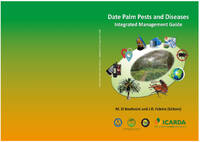Geoinformaticas application in Date-Palm-Pests-and-Diseases

Authors:
Global climate variability and change (and framing system) pose a serious threat to food
and to nutritional security, with increased concerns of agricultural risks and vulnerability to
pests and diseases. The nature and magnitude of the risks and threats to the vulnerability
of crops to insect pests and diseases are not yet well-defined and uncertain in terms of
spatio-temporal distributions under ever changing bio-physical and plant physiological
conditions. This hinders the effective implementation of the pest management strategies
and planning of integrated pest management (IPM). One of the foremost preventive
measures is to map the vulnerability of crops to specific pests and diseases. The spatial and
temporal hotspots are used to curb and to mitigate the risks in advance and/or to take
action on already prevailing outbreaks in order to prevent further spread. At the larger
scales, fundamental ecological concepts that address factors governing species distribution
were often the foundation for the development of pest risk and vulnerability maps at regional and global scales (Biradar etal., 2014). However, at local scales, such as farm level management of pests, the use of the regular and in-situ monitoring protocols is required to better understand the risks for the
proper management at field scales. The spatial model combined geo-spatial climate data,
crop and host phenology, persistence of pests and similarity conditions in conjunction with
in-situ observations. This type of risk analysis helps to measure the persistence of the pests
at a given time and location and the potential risks, vulnerability, and subsequent epidemic
outbreaks in a given location.
Geoinformatics tools and technology (GIS, RS, GPS, modeling, web apps) can be used to
collect, archive, analyze, and visualize pests and diseases efficiently and economically for
the integrated pest and disease management practices. In this chapter, we outline the
geoinformatics technology and its potential application in mapping, monitoring, and
management of the pest risks to help with the effective implementation of the IPM.
Managers/decision makers at farm level need to understand the variability of the risks at
spatio-temporal scales and decide when and where to use IPM practices and relevant
control measures to reduce the risk and economic damages.
